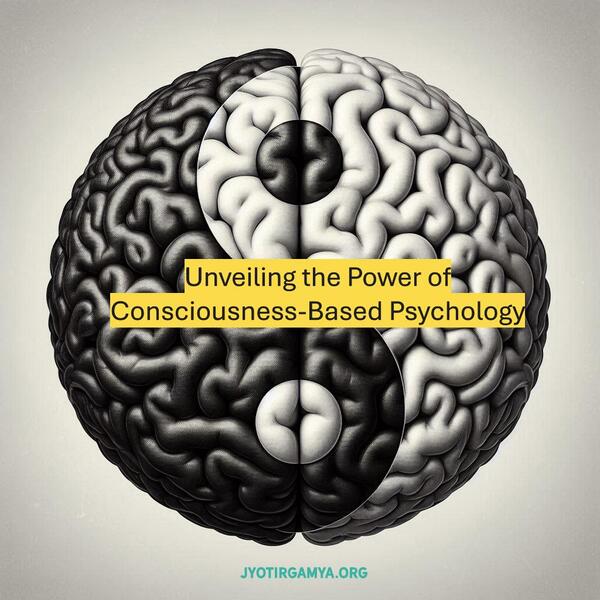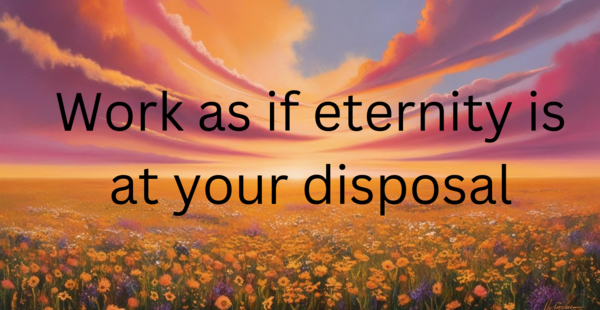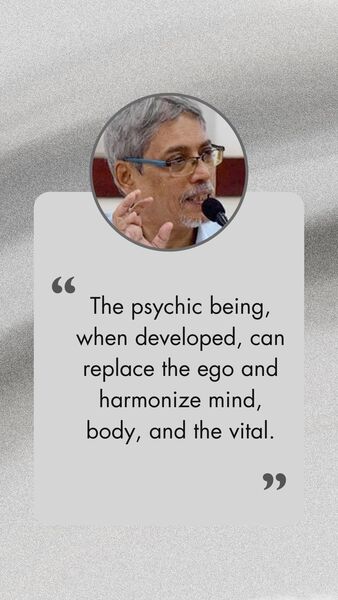Integrating East and West: Unveiling the Power of Consciousness-Based Psychology
This interview with Dr. Soumitra Basu, a psychiatrist and co-developer of Consciousness-Based Psychology (CBP), explores a unique approach to mental well-being.
CBP draws from the work of Sri Aurobindo and The Mother, two influential figures in the field of integral yoga and spiritual philosophy.
Dr. Basu explains how CBP differs from traditional Western psychology by focusing on the evolving nature of consciousness, including the concept of a “psychic being” - a deeper aspect of self. He discusses how this perspective influences his understanding of mental health, healing, and personal growth, offering a fresh look at the human experience.
CBP is not a synthesis of existing models but a distinct framework rooted in Sri Aurobindo’s work, aiming to expand Western psychology through a consciousness-driven approach.

How does Sri Aurobindo’s philosophy on consciousness influence your approach to psychiatry?
Sri Aurobindo’s work introduced me to the idea that consciousness evolves through stages, preceding with involution (the descent of superconsciousness into matter) and leading to higher states like the supermind. This shifted my focus from the mind as the endpoint of evolution to a broader framework where the mind is just one layer.
For example, he describes layers above the mind—intuitive, illumined, and overmind—which intrigued me. This perspective reshapes psychiatry by addressing mental health as part of a larger evolutionary process, not just a biological or cognitive issue.
How does Consciousness-Based Psychology differ from traditional Western models?
Traditional psychology often focuses on the outer being (ego-driven personality), but Consciousness-Based Psychology (CBP) centers on the inner being (deeper consciousness layers) and the inmost being (psychic being).
For instance, modern therapy might treat anxiety with CBT, but CBP would explore how misalignment between physical, emotional, and mental layers (e.g., wanting to exercise but feeling lethargic) disrupts inner harmony. CBP also integrates Eastern concepts like cosmic consciousness and soul evolution, which Western models lack.
How does Sri Aurobindo’s concept of the psychic being influence your approach to psychological healing and personal transformation?
The psychic being is essential for integrating the mind, body, and vital energy. These systems often conflict, especially around the ego, which can be biased towards the mind, vital, or physical body.
The psychic being, when developed, can replace the ego and harmonize these systems. This integration is crucial for psychological healing and personal transformation, as it allows the individual to move beyond the limitations of the ego and access higher levels of consciousness.
What is the role of the “psychic being” in personal growth?
The psychic being, according to Sri Aurobindo, is a projection of the soul (jivatma) within the manifest world. The psychic being is the evolving core of our individuality, carrying profound emotional memories (e.g., turning points in life) across lifetimes.
Unlike the ego, it’s free from negativity and bias. By connecting with it, we can replace ego-driven habits with soul-guided clarity.
For example, someone struggling with career choices might tap into their psychic being to align with their true purpose, rather than societal pressures. This process fosters lasting mental well-being by harmonizing the inner being with the outer world.
How can individuals navigate mental health challenges in a modern world full of distractions and stress?
Sri Aurobindo’s approach is integral and holistic, emphasizing inner discipline as key to mental and spiritual growth. His concept of the higher mind, which deals simultaneously with contradictory and complementary ideas, can be particularly useful in today’s discordant world.

Modern executives suffer from “Time Anxiety,” accelerating heart disease rates. Sri Aurobindo’s Solution - “Do not compete with time—befriend it.”" Work as if eternity is at your disposal, allowing time to align with your effort.
Key Psychological Shift: The Inner Being must stabilize first before outer efficiency can be sustained without stress.
By cultivating the higher mind, individuals can better manage stress and anxiety, leading to improved mental health. Practices like mindfulness and meditation can help align the inner being with the higher mind, promoting resilience and emotional regulation.
What does the future of psychology look like through the lens of CBP?
The future lies in integrating Eastern wisdom with Western science. CBP predicts a shift toward “supermental” beings—humans embodying divine consciousness in matter. Education systems will foster higher mental faculties (e.g., intuitive thinking), and therapies will blend yogic principles with evidence-based methods. This paradigm shift moves beyond symptom management to soul-driven transformation.
What are some common misunderstandings about Sri Aurobindo’s approach to psychology, and how can they be addressed?
One common misunderstanding is that Sri Aurobindo’s philosophy is overly complex or not applicable to modern psychology. However, his teachings have been integrated into Indian psychology and are gaining recognition in transpersonal psychology.
Another misunderstanding is the role of the ego, which Sri Aurobindo discusses from metaphysical, psychological, and evolutionary angles. The ego is seen as a helper that can eventually be replaced by the psychic being. Addressing these misunderstandings involves educating people about the practical applications of his teachings and their relevance to modern mental health challenges.
Parting Thoughts
Dr. Basu’s discussion of CBP offers a new way to think about psychology, one that considers the whole person, including their spiritual dimension. He highlights the importance of understanding consciousness and the role of the psychic being in navigating life’s challenges.
CBP suggests that by exploring these deeper layers of ourselves, we can find greater harmony and meaning. This approach, rooted in the wisdom of Sri Aurobindo and The Mother, invites us to consider not just our minds, but also our inner being, in the pursuit of well-being and a more complete understanding of what it means to be human.
About the Guest
Dr. Soumitra Basu, MD, DPM, is a Consultant Psychiatrist based in India. His work focuses on integrating Sri Aurobindo’s spiritual philosophy into modern psychiatric practices, particularly through developing consciousness paradigms in health and psychology.

Dr. Basu contributes as an editor for the Journal of Integral Health, NAMAH, and holds significant roles in various institutions, including Founder-Director at the Sri Aurobindo International Institute of Integral Health and Research and Honorary Director at the Institute of Integral Yoga Psychology.
Additionally, Dr. Basu is the Honorary Secretary of the Mirravision Trust and manages the Centre for Consciousness Studies at Sri Aurobindo Ashram. His academic contributions include serving as a senior Faculty in Social Work at Vidyasagar University and as an extra-mural Faculty in Indian Psychology at Calcutta University.
He is an accomplished author, with works including Integral Health, Integral Education, and co-authoring Consciousness Based Psychology - Sri Aurobindo’s Vision of Yoga, Health and Transpersonal Growth. Dr. Basu is active in conducting workshops and delivering lectures on psychological growth and stress management in various settings, furthering the application of consciousness-based models in both academic and corporate sectors.
Glossary of Key Terms
- Outer Being: Surface personality shaped by ego, physical, vital, and mental aspects.
- Inner Being: Deeper consciousness layers (inner mind, vital, physical) bridging the outer and inmost being.
- Inmost Being (Psychic Being): Evolving core of individuality, storing transformative soul-experiences.
- Involution: The descent of consciousness into matter, forming fixed typal worlds (e.g., supermind, overmind).
- Evolution: The awakening of hidden consciousness through pressure from below (inconscient resistance) and influence from above (typal worlds).
- Supermind: Highest state of consciousness integrating contradictions into oneness.
Further Reading
Play Therapy: A Powerful Tool for Mental Health
Insights on Therapy, Growth, and Decision-Making from a Mental Health Community Discussion
Achieving Work-Life Balance with Acceptance and Commitment Therapy (ACT)
The Benefits of Mindfulness in Acceptance and Commitment Therapy
How Hypnotherapy Can Help You Heal Jealousy and Insecurity
Sound Therapy for Learning and Pain
Decoding the Differences: CBT vs. ACT vs. DBT Unveiled
Unveiling the Secrets of Healing: A Conversation with Renowned Therapist Mitch Davidowitz
Your Guide to Avoiding Pop-Psych & Finding Effective Therapy
The Forgiver’s Dilemma: Can Letting Go Set You Free?
Inner Child Healing: The Key to Unlocking Your Potential
Conquer Anxiety with Hypnotherapy
NLP for Sleep: A Science-Backed Guide to Falling Asleep Faster and Improving Sleep Quality
Want to stay connected? Here’s our twitter.
Or subscribe to our monthly newsletter containing tools for body, mind, and goal.